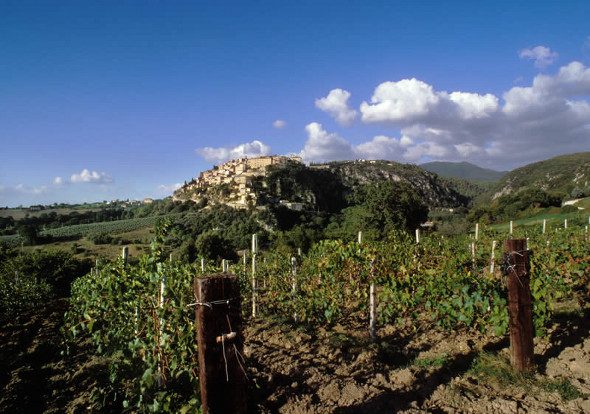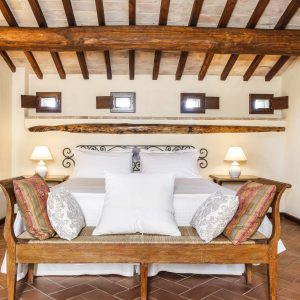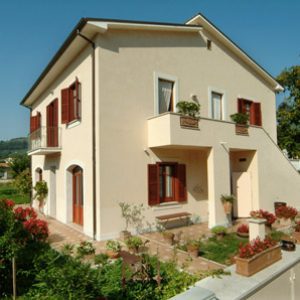▌ Discover Calvi dell’Umbria
#BELLAUMBRIA
{“translation”:[{“lang”:”it”,”content”:”
Calvi dell’Umbria, l’antica Carbium, è anche definita “la porta felice dell’Umbria”. Adagiata su uno sperone roccioso tra verdeggianti colline digradanti verso il tevere, a ridosso del monte San Pancrazio, si erge a 410 metri sul livello del mare circondata da viti ed ulivi.
Distante da Otricoli solo 9 Km, è una terra antica, ricca di storia, di arte e di tradizioni. Già abitata nell’età del Bronzo, la sommità del monte San Pancrazio conserva i resti di un centro di culto del VI secolo. Il paese in sé ha invece origini romane, dimostrate dal ritrovamento di un’ara funeraria, monete ed altro.
>>Vuoi vedere Calvi dell’Umbria? Consulta ora le offerte dei migliori agriturismi nelle vicinanze.

Arrivati in piazza, ci si trova di fronte all’elegante Chiesa di Santa Brigida, antistante il grande complesso monumentale del Monastero delle Orsoline, costruito nel 1744 assieme all’annessa Chiesa di San Antonio. In quest’ultima trova alloggio un pregevolissimo Presepe in terracotta policroma costituito da trenta figure, alcune in grandezza naturale, databile alla prima metà del XVI secolo. Autori dell’opera sembrerebbero, secondo la tradizione, i fratelli abruzzesi Giovanni e Raffaele da Montireale.
Di notevole interesse storico e artistico sono la chiesa a pianta ottagonale della SS. Trinità, eretta nella prima metà del ‘400, e la chiesa parrocchiale di Santa Maria Assunta che conserva pregevoli dipinti. Calvi dell’Umbria è conosciuta anche come il paese dei presepi, e non solo a causa del presepe in terracotta di cui si è parlato. Infatti moltissime scene della natività, realizzate di recente in forma di murales da noti pittori italiani e stranieri, abbelliscono oggi i muri delle vecchie case. Come se non bastasse, durante il periodo natalizio, il paese ospita un famoso presepe vivente. Nel mese di maggio di ogni anno, hanno luogo fin dal medievo le cerimonie religiose e le rievocazioni storiche legate alla festa di San Pancrazio patrono del paese e protettore delle libertà comunali. Nel giorno del Corpus Domini viene stesa sulle vie ed i vicoli del centro storico una suggestiva e variopinta infiorata.
“},{“lang”:”en”,”content”:”Calvi dell’Umbria, the ancient Carbium, also is defined the happy door of Umbria. Carefullied layed down on one spur full of rocks between green hills towards the river Tevere, it is located at 410 meters above sea level.
Distant from Otricoli only 9 Km, is one ancient earth, rich of history, art and traditions. Already risen in the age of the Bronze, the top of the San Pancrazio mount still conserves the rests of a culture dated around the V century. The village in himself has instead Roman origins, demonstrated from the recent finding of plows, coins and other objects.
In the XI century, Calvi bacame property of the Abbey of Farfa, and was uninterrupted dominion of the Orsini family, which was associated with the Pope, dominion which only finishes in the 1572. A lot of continuous and often violent and bloody fights for issues related with the relative borders the with close castles lightened the town and its abitant, at that point that, in order to bring peace between the different parts, the pope Callisto III had to name a commissioner. In 1798 the french troops plundered the country. Under Leone XII (1823-1829) the transition from the jurisdiction of the Sabina to that one of the Narni took place. The village must to this its belongings today to the region Umbria. To visit the town, passing towards the main public square,results in typical and colorful middle age ways, between ancient houses, towers, arches.
Once arrived in the main public square, the great monumental complex of the Monastero of the Orsoline, constructed in 1744 to the annexed Church of San Antonio is reached. In this last one a delightfull multicoloured porcelain representing thirty figures, finds lodging, dated the first half of the XVI century. Authors of the work would be, according to the tradition, Giovanni and Raffaele da Montireale. Of remarkable historical and artistic interest are the churches of octagonal plant, of SS. Trinità, erected in the first half of the ‘ 400, and the parochial church of Saint Assunta Maria which conserves paintings of great value on its inside. Calvi dell’Umbria is known also as the country of the mangers. In fact very many scenes of the Presepe (nativity), realization of recent murales from famous Italian and foreign painters, today embellishes the walls of the old houses. In addiction, during the Christmas period, the country accommodates a famous living manger. During the month of May of each year, the religious ceremonies and the historical events from middleage take place, evocating the festivity of Saint Pancrazio, patron of the protecting country and of the communal freedoms. In the day of the Corpus Dominis, the fest called in italian the infiorata occurs, with flowers spreaded on the ways and the alleys of the historical center becoming evocative and rich of colors.
“},{“lang”:”de”,”content”:”Calvi dell’Umbria, the ancient Carbium, also is defined the happy door of Umbria. Carefullied layed down on one spur full of rocks between green hills towards the river Tevere, it is located at 410 meters above sea level.
Distant from Otricoli only 9 Km, is one ancient earth, rich of history, art and traditions. Already risen in the age of the Bronze, the top of the San Pancrazio mount still conserves the rests of a culture dated around the V century. The village in himself has instead Roman origins, demonstrated from the recent finding of plows, coins and other objects.
In the XI century, Calvi bacame property of the Abbey of Farfa, and was uninterrupted dominion of the Orsini family, which was associated with the Pope, dominion which only finishes in the 1572. A lot of continuou
s and often violent and bloody fights for issues related with the relative borders the with close castles lightened the town and its abitant, at that point that, in order to bring peace between the different parts, the pope Callisto III had to name a commissioner. In 1798 the french troops plundered the country. Under Leone XII (1823-1829) the transition from the jurisdiction of the Sabina to that one of the Narni took place. The village must to this its belongings today to the region Umbria. To visit the town, passing towards the main public square,results in typical and colorful middle age ways, between ancient houses, towers, arches.
Once arrived in the main public square, the great monumental complex of the Monastero of the Orsoline, constructed in 1744 to the annexed Church of San Antonio is reached. In this last one a delightfull multicoloured porcelain representing thirty figures, finds lodging, dated the first half of the XVI century. Authors of the work would be, according to the tradition, Giovanni and Raffaele da Montireale. Of remarkable historical and artistic interest are the churches of octagonal plant, of SS. Trinità, erected in the first half of the ‘ 400, and the parochial church of Saint Assunta Maria which conserves paintings of great value on its inside. Calvi dell’Umbria is known also as the country of the mangers. In fact very many scenes of the Presepe (nativity), realization of recent murales from famous Italian and foreign painters, today embellishes the walls of the old houses. In addiction, during the Christmas period, the country accommodates a famous living manger. During the month of May of each year, the religious ceremonies and the historical events from middleage take place, evocating the festivity of Saint Pancrazio, patron of the protecting country and of the communal freedoms. In the day of the Corpus Dominis, the fest called in italian the infiorata occurs, with flowers spreaded on the ways and the alleys of the historical center becoming evocative and rich of colors.
“},{“lang”:”es”,”content”:”Calvi dell’Umbria, the ancient Carbium, also is defined the happy door of Umbria. Carefullied layed down on one spur full of rocks between green hills towards the river Tevere, it is located at 410 meters above sea level.
Distant from Otricoli only 9 Km, is one ancient earth, rich of history, art and traditions. Already risen in the age of the Bronze, the top of the San Pancrazio mount still conserves the rests of a culture dated around the V century. The village in himself has instead Roman origins, demonstrated from the recent finding of plows, coins and other objects.
In the XI century, Calvi bacame property of the Abbey of Farfa, and was uninterrupted dominion of the Orsini family, which was associated with the Pope, dominion which only finishes in the 1572. A lot of continuous and often violent and bloody fights for issues related with the relative borders the with close castles lightened the town and its abitant, at that point that, in order to bring peace between the different parts, the pope Callisto III had to name a commissioner. In 1798 the french troops plundered the country. Under Leone XII (1823-1829) the transition from the jurisdiction of the Sabina to that one of the Narni took place. The village must to this its belongings today to the region Umbria. To visit the town, passing towards the main public square,results in typical and colorful middle age ways, between ancient houses, towers, arches.
Once arrived in the main public square, the great monumental complex of the Monastero of the Orsoline, constructed in 1744 to the annexed Church of San Antonio is reached. In this last one a delightfull multicoloured porcelain representing thirty figures, finds lodging, dated the first half of the XVI century. Authors of the work would be, according to the tradition, Giovanni and Raffaele da Montireale. Of remarkable historical and artistic interest are the churches of octagonal plant, of SS. Trinità, erected in the first half of the ‘ 400, and the parochial church of Saint Assunta Maria which conserves paintings of great value on its inside. Calvi dell’Umbria is known also as the country of the mangers. In fact very many scenes of the Presepe (nativity), realization of recent murales from famous Italian and foreign painters, today embellishes the walls of the old houses. In addiction, during the Christmas period, the country accommodates a famous living manger. During the month of May of each year, the religious ceremonies and the historical events from middleage take place, evocating the festivity of Saint Pancrazio, patron of the protecting country and of the communal freedoms. In the day of the Corpus Dominis, the fest called in italian the infiorata occurs, with flowers spreaded on the ways and the alleys of the historical center becoming evocative and rich of colors.
“},{“lang”:”fr”,”content”:”Calvi dell’Umbria, l’antique Carbium, est également appelée “la porte heureuse de l’Ombrie”. Appuyée contre une paroi rocheuse au milieu de vertes collines portant vers le fleuve, près du Mont San Pancrazio, elle se trouve à 410 mètres au-dessus du niveau de la mer, entourée de vignes et d’oliviers.
A seulement 9 kilomètres d’Otricoli, c’est une terre antique, riche d’histoire, d’art et de traditions. Déjà habitée à l’age du bronze, le sommet du Mont San Pancrazio conserve les restes d’un centre de culte du VIème siècle. Le village en soi a en revanche des origines romaines, démontrées par la découverte d’une zone funèbre, de monnaies et d’autres objets.
Au XIème siècle, Calvi devient la propriété de l’Abbaye de Farfa, et appartint de façon ininterrompue aux Orsini en tant que vicaires du Pape, domination qui se termine seulement en 1572. Les luttes avec le château voisin de Poggio furent continues et souvent violentes et sanguinaires pour des questions concernant les frontières, à tel point que pour imposer la paix entre les parties Callisto III dû nommer un commissaire. En 1798 les troupes françaises saccagèrent le village. Sous Léon XII (1823-1829) a lieu le passage de la juridiction de la Sabina à celle du Diocèse de Narni. C’est à cela que l’on doit aujourd’hui son appartenance à la région Ombrie. En remontant vers la place principale, on passe à travers des petites rues médiévales typiques et pittoresques, au milieu de maisons antiques, de tours, d’arcs et de voûtes.
Arrivés sur la place, on se trouve en face de l’élégante église de Sainte Brigida, qui se trouve devant le monumental ensemble du Monastère des Ursulines, construit en 1744 avec l’église annexe de Saint Antoine. Au sein de celle-ci se trouve une précieuse crèche en terre cuite polychrome faite de trente figurines, dont certaines grandeur nature, que l’on peut dater de la première moitié du XVIème siècle. Les auteurs de l’ouuvre sembleraient, selon la tradition, les frères Giovanni et Raffaele da Montireale, provenant de la région Abruzzo.
Sont également de grand intérêt historique et artistique l’église octogonale de la Ste. Trinité, construite au cours de la première moitié du XVème siècle, et l’église paroissiale de Sainte Marie Assunta qui conserve de précieuses peintures. Calvi dell’Umbria est également connu comme le village des crèches, et pas seulement pour la crèche en terre suite dont nous avons déjà parlé. En effet, de nombreuses scènes de la nativité, réalisées récemment sous la forme de peintures murales par des peintres italiens et étrangers connus, embellissent aujourd’hui les murs des vieilles maisons. Comme si cela ne suffisait pas, pendant la période de Noël, le village accueille une célèbre crèche vivante. Tous les ans au mois de mai, et ceci depuis la fin du Moyen-Âge, ont lieu les cérémonies religieuses et les évocations historiques liées à la fête de San Pancrazio,
patron du village et protecteur des libertés communales. Le jour du Corpus Domini est étendue dans les rues du centre historique une belle fioriture.
“}]}


